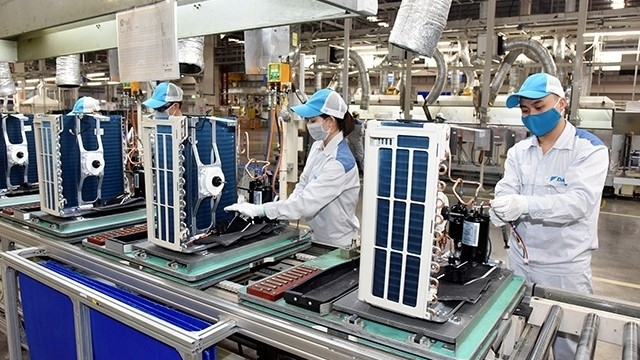 |
|
Daikin Air Conditioning (Vietnam) Joint Stock Company at Thang Long II industrial park in Hung Yen |
Light segment of the economic picture
The resolution aims at a synchronous, consistent and transparent approach to internationally advanced standards as well as harmony with international commitments in order to attract strategic investors and multinational corporations to invest, open their head offices and establish research and development centres and creative innovation centres in Vietnam.
The resolution will also contribute to enhancing the link between foreign direct investment (FDI) and domestic enterprises as well as encourage increased technology and management transfer for Vietnamese businesses.
Resolution No.50/NQ-TW sets the goal of registered capital reaching around US$150 billion – US$200 billion during the 2021-2025 period and around US$200 billion – US$300 billion during the 2026-2030 period; implemented capital reaching about US$100 billion – US$150 billion and US$150 billion – US$200 billion respectively.
The two goals are feasible because Vietnam attracted US$35.97 billion of foreign investment capital and realised capital reached US$20.38 billion in 2019. Therefore, an average growth rate of 7%-8% per year is realisable.
Foreign direct investment is a bright segment of Vietnam's economic picture in 2019. As of December 20, 2019, realised FDI capital reached US$20.38%, a year-on-year increase of 6.7%.
Total newly registered, adjusted and contributed capital of foreign investors was nearly US$36 billion, up 1.4$ over the previous year. FDI enterprises have a total export turnover (including crude oil) of US$181.35 billion, up 4.2% over 2018 and accounting for 68.8% of the whole country’s export turnover.
Meanwhile, import turnover reached US$145.5 billion, up 2.5% and accounting for 57.4% of the country’s total. This economic sector also saw a trade surplus of nearly US$35.68 billion, not only offsetting the trade deficit of the domestic economic sector but also adding an export surplus of US$11.2 billion to the economy.
Three determinants
The distribution of FDI capital into economic sectors continued to hold the same level as previous years. Mergers and acquisitions (M&A) activity was more active, accounting for an increasing proportion of the total registered capital, from 17.02% in 2017 to 27.78% in 2018 and 37.3% in 2019.
This is a good sign because the larger scale of domestic business created an abundant supply for M&A and the opening policy of the stock market as well as expanding room for foreign investors.
According to the United Nations Conference on Trade and Development (UNCTAD), the FDI into developing countries in Asia reached US$512 billion, an increase of 3.9% on 2018 ,accounting for 39% of total global FDI; meanwhile the FDI into Southeast Asia was a record US$149 billion, up 3%. In particular, Singapore, Indonesia, Vietnam and Thailand witnessed relatively high growth. Manufacturing, services, wholesale, retail and digital sectors in ASEAN countries attracted the most FDI capital.
Many reports showed that due to the impact of US-China trade tensions, many American, European and Asian investors are moving their factories from China to their countries or third countries, Vietnam being a leading choice.
Overall, the quality and efficiency of FDI in 2019 did not meet the country's requirements in relation to the transition towards creative innovation, science – technology and high-quality human resources, the industrial revolution 4.0 and the building of the digital eocnomy.
The average size of each FDI project is too small, with around US$4 billion per project, showing a lack of large-scale entities. In 2018, the largest projects were the construction of a smart city in Dong Anh District (Hanoi) worth US$4.14 billion and the building of a Polypropylene factory and a liquefied petroleum storage depot funded by the Republic of Korea (RoK) in Ba Ria – Vung Tau province, totaling US$1.2 billion. The largest project in 2019 was worth only US$420 million.
In the processing and manufacturing industries, there have not been many projects in terms of future technology like artificial intelligence (AI), block chain, fintech and research and development (R&D), especially in the two major economic centres of Hanoi and Ho Chi Minh City.
In order to achieve the goal of FDI quality set by Resolution No.50, Vietnam should change its mindset and actions toward selecting partners and FDI projects because these are issues related to technology transfer, corporate governance, high-quality human resources training and joining in the global supply chain.
It is essential to attract more FDI from Japan, the RoK, Singapore and Asia as well as rapidly increase large-scale investment projects from the US, Germany, France, the UK and several other European countries into modern and future technology, education and training and R&D.
In addition to encouraging medium and small enterprises to invest in Vietnam, the relevant agenices should attract more transnational companies from the world’s top 500 on projects worth billions of US dollars. The FDI projects into the localities should be consistent with the development level of each province and city.
In order to achieve these goals, Vietnam should perfect its political and economic institutions, create an attractive investment and business environment and choose the right projects and foreign investors.
These are the three determinants to implement the correct FDI direction. It is essential to promote specific measures, including accelerating the transition to a digital, circulating and green economy.
The ministries, agencies, localities, and the management boards of economic and industrial zones should simultaneously carry out these strategies to attract FDI through e-government and digital government, creating breakthroughs while building a list of FDI projects towards large scale and high quality.
The relevant agencies should synchronously innovate in relation to investment promotional activities and the standards needed for investment certification as well as monitor, support and inspect the operation of enterprises.
It is crucial to take advantage of these new opportunities as the country’s position has been raised both regionally and internationally and several FDI factories have been moved to Vietnam in order to select potential investors for high-quality and large-scale projects.
The decisive factor is to reform the state apparatus towards e-government and digital government to serve people and businesses effectively and efficiently. Nhan Dan
Prof. Dr. Nguyen Mai - Chairman of the Vietnam Association of Foreign Invested Enterprises

Fine-tuned policies needed to unleash foreign investment in Vietnam’s M&A market
A survey by Corporate Investment and Mergers & Acquisitions Center also showed that one of the obstacles to M&A deals in Vietnam is the time consuming approval process.

Education draws foreign investment
As of 2019, Vietnam counted five foreign invested universities, 68 private schools and 170 public ones.
 The Politburo has issued Resolution No.50/NQ-TW on August 20, 2019, outlining directions to perfect institutions and policies to improve foreign investment efficiency and cooperation until 2030.
The Politburo has issued Resolution No.50/NQ-TW on August 20, 2019, outlining directions to perfect institutions and policies to improve foreign investment efficiency and cooperation until 2030.